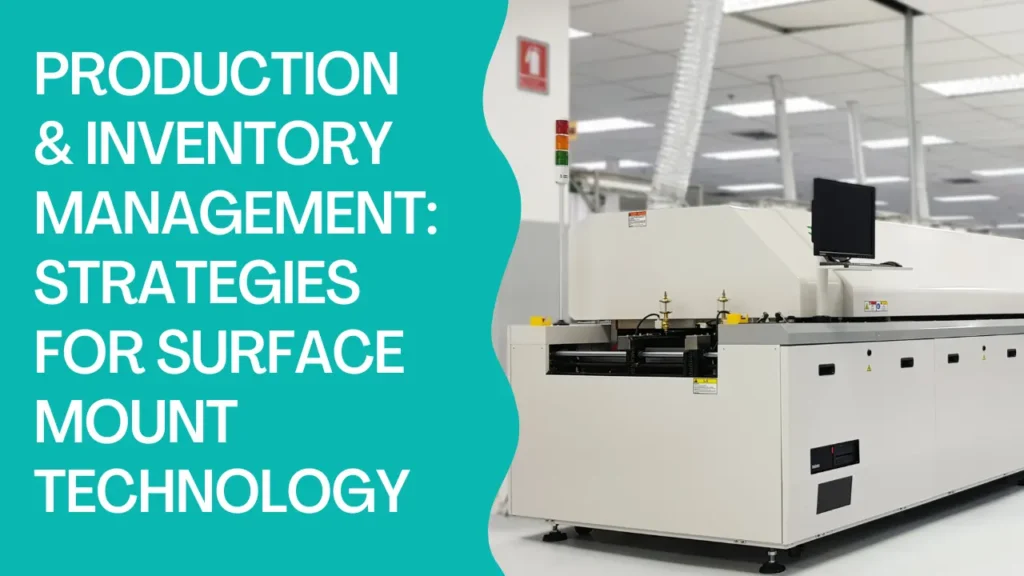In the world of surface mount technology (SMT), production and inventory management are key to any successful operation. That’s why it’s important to have the right production and inventory management strategies in place in order to keep your SMT operations running smoothly. Here the Manufacturing Execution System (MES) plays a vital role in optimizing and managing Surface Mount Technology (SMT) lines. SMT lines are commonly used in electronics manufacturing, where electronic components are mounted into circuit boards.
In this article, we will give you an overview of the production and inventory management strategies you should consider when managing your SMT operations. We will go over the different types of production processes, inventory management methods, and materials handling strategies that are essential for effective SMT operations. By the end of this article, you will have a better understanding of how to manage your SMT operations more efficiently and effectively.
What Is Surface Mount Technology?
Surface mount technology (SMT) is a type of engineering that uses components mounted directly onto the surface of a printed circuit board (PCB). This type of technology is used in a variety of products, from consumer electronics to medical devices, as it allows components to be densely packed together and designed on a much smaller scale than traditional manufacturing techniques.
The key to successful surface mount technology production is inventory and production management. With careful inventory management, you can reduce waste and save money on purchasing unneeded parts. Additionally, through optimized production scheduling, you can increase productivity and reduce downtime during workflows.
In short, effective inventory and production management allow for a smoother flow of products from the factory floor all the way to the customer’s hands. When done correctly, they’ll help make sure your surface mount technology products are built with precision and quality every time. Our blog on Role of technology in improving Production and Inventory Management highlights more on the topic.
We can get more information about the future of SMT with the article on Allied Market Research by visiting https://www.alliedmarketresearch.com/surface-mount-technology-market-A08877.
The Benefits of Automation in SMT Production Lines
The manufacturing world is buzzing with the advantages of automation and it’s no surprise that incorporating a few automated processes into your surface mount technology (SMT) production line can do wonders for your operations. Automation helps to reduce errors, increase efficiency, and reduce labour costs.
Here are some of the benefits of automation in SMT production lines:
[vc_row_inner css=”.vc_custom_1683718003439{margin-top: 40px !important; margin-bottom: 40px!important}”][vc_column_inner width=”1/2″][vc_single_image image=”113620″ img_size=”full” alignment=”center”][/vc_column_inner][vc_column_inner width=”1/2″][vc_column_text]
- Improved Accuracy: Automated systems are less prone to human error, so the accuracy of the production line goes up significantly when automation is implemented. This improves product quality and reliability which in turn results in higher customer satisfaction.
- Reduced Labor Costs: Automating processes leads to fewer personnel required in the production line, reducing labor costs as well as improving safety conditions.
- Minimized Waste: Automation can help optimize production cycles while minimizing waste on unused materials, resulting in cost savings on raw materials and energy consumption.
- Increased Productivity: With processes automated, fewer resources need to be allocated to each task and more tasks can be completed within a shorter time frame. This leads to increased productivity as well as increased output capacity.
In reference to above we would like to give some time on our blog Manufacturing Execution System for Heavy Engineering Industry which will help you understand MES role in the industry.
[/vc_column_text][/vc_column_inner][/vc_row_inner][vc_row_inner][vc_column_inner][vc_column_text]
Setting Up Effective Inventory Management Systems
Having an effective inventory and production management system in place for surface mount technology is essential for any business. From understanding how much stock you’re holding and to make sure products are produced and shipped in a timely manner, proper management can make a huge difference. So, let’s take a look at some of the strategies you can implement to ensure effective inventory and production management.
Automate Inventory Tracking
A key part of effective inventory and production management is keeping track of stock levels. Making sure you have accurate records of your stock takes time and effort, but automation tools make things easier for busy buyers. Automated tools can help you keep track of how much stock you have on hand, how long products take time to arrive from suppliers and when can we place the orders. This gives you more control over your supply chain, ensuring that the right products are available when they’re needed.
Monitor Production Schedule
Monitoring your production schedule is another important part of efficient inventory and production management. By being aware of what’s expected to be produced each day or week, it’s easier to stay on track with orders and reduce delays in shipments. Keeping an eye on your production schedule also helps you anticipate capacity issues before they become a problem and makes it possible to quickly adjust operations when needed.
Improve Logistics Efficiency
Optimizing the logistics process is another way to improve efficiency in production and inventory management—meaning it may be time to rethink shipping methods or order policies. Working with experienced logistics professionals can help simplify processes like order processing, routing orders and tracking shipments, which all contribute to improved efficiency in your operations.
These are just some strategies that can help streamline inventory and production management for surface mount technology
Implementing an MES (Manufacturing Execution System)
When it comes to production and inventory management for surface mount technology, have you ever considered implementing an MES (Manufacturing Execution System)? This modern system can provide you with a host of benefits, from more efficient production planning and scheduling, to improved material flow traceability.
An MES (Manufacturing Execution System) can also help you with:
- Automated data collection and analysis: An automated system makes it easier to collect real-time data from the shop floor and analyze it for insights into production efficiency.
- Accurate tracking of components and assemblies: The MES helps improve the accuracy of inventory tracking, so you always know what parts are available and where they are located.
- Improved quality control: The MES helps ensure that all the components in the product meet their quality standards.
- Increased visibility: With an MES in place, managers can easily track production in real-time to see where he can make the improvements.
An effective MES system should be able to provide all of these benefits in one convenient package. Investing in an MES system is a smart choice for businesses looking to maximize their production efficiency and streamline inventory management.
Evaluating Your Production & Manufacturing Efficiency & Output
Nobody likes wastage — and the same applies to production and manufacturing for surface mount technology. To ensure that you’re meeting your goals, it’s important to occasionally evaluate your processes to reduce wastage and increase efficiency.
Here are some strategies you can use:
- Invest in the right equipment. For good quality manufacturing equipment make sure that each product is made with consistent results, helping the organization to meet production targets faster and more accurately. Investing in the right machines can save time (and money) while producing higher quality products.
- Automation may help lower costs and eliminate human error. Automating various processes like soldering, pick-and-place assembly or material testing could help you increase throughput while reducing errors and labor costs — not to mention time savings!
- Keep track of inventory levels at all times with an ERP or WMS system; this will help you easily monitor your inventory levels and stay on top of reorders so that you don’t run out of essential supplies and parts necessary for production operations.
- Utilize forecasting tools to plan ahead for future demand; this ensures that you have sufficient inventory on hand when needed without excess stock tying up valuable capital resources.
By evaluating your production and manufacturing efficiencies regularly, you’re able to monitor how well your team is performing against set targets, as well as identify potential opportunities for improvement — from automating processes to investing in better equipment or software systems.
Best Practices for Improved Productivity & Quality Control in SMT
You may have heard of surface-mount technology (SMT) production, but do you know the best practices to ensure improved productivity and high quality control? Here are some tips you can use to get the most out of your SMT production line:
Schedule regular maintenance
Regular maintenance helps to reduce downtime and keep your equipment running at peak performance. Scheduling regular checkups can help you identify potential problems before they become bigger issues.
Invest in technology and automation
Investing in the latest technologies can help you streamline operations, reduce errors, and increase productivity. Automating certain processes like board manufacturing and screen printing can help speed up the production process.
Train employees
Investing in proper training for your employees is essential for any successful SMT line. Providing thorough training on how to operate machinery correctly and safely will help eliminate human errors that can cause costly delays or quality issues.
By implementing these best practices for your SMT production, you will be able to get more out of your SMT line while also improving productivity and quality control.
Summary
Streamlining inventory and production management processes in surface mount technology enables cost and time savings while enhancing product quality. Efficient systems, processes, facilities, and skilled personnel are essential to maximize production line efficiency and performance. Proactive inventory monitoring, demand forecasting, and improved component traceability contribute to achieving production goals, minimizing errors, and enhancing operational visibility. Embracing a holistic approach to production and inventory management optimizes resources and boosts profitability in surface mount technology. Take the necessary steps to ensure a productive and profitable production line.
[/vc_column_text][/vc_column_inner][/vc_row_inner]





